INTRODUCTION
Acne is a common skin disorder of the sebaceous follicles, which occurs when our pores get clogged due to an overproduction of sebum (the oil produced to lubricate our skin) and an accumulation of dead skin cells (due to excessive cell proliferation), that result from an inflammatory process induced by hormones and acne-related bacteria.
Many factors have been associated with the development of acne, including our diet. Although science has not concluded how food and acne relate, some studies have helped to elucidate the potential mechanisms by which some foods could cause acne. In this article, we will explore 7 of the foods that may influence this skin condition and why (according to the evidence available), and what to eat instead.
1.
SUGAR
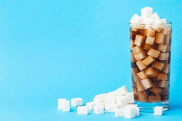
Foods rich in sugar such as candy, soda, sugar-sweetened beverages, sweeteners (like honey, maple syrup, and agave), ice cream, barbecue sauce, ketchup, etc. may cause acne due to their high sugar content. These foods have a
“high glycemic load”
, which means that the sugar in them is readily available to be absorbed into the bloodstream, quickly increasing blood sugar levels, which induces the release of insulin to keep sugar (aka glucose) levels within the normal values.
Why can sugar cause acne?
Foods with a high glycemic load are suspected to contribute to acne due to their ability to induce the release of high amounts of insulin, which may stimulate the proliferation of sebaceous gland cells (sebocytes) and sebum production, as well as raise androgen concentrations, [1], factors associated with the pathogenesis of acne.
2.
REFINED GRAINS
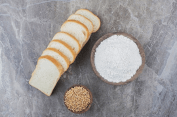
White bread, white rice, rice noodles, and food made with white flour (pasta, desserts, cakes, crackers, cookies, etc.) are in this group. Refined grains are characterized by the removal of the bran (fiber-rich) and germ present in the whole grain, placing them in the category of “refined carbohydrates”, such as sugars. In this sense, they have also a
“high glycemic load”
, rich in simple carbohydrates easy to digest and absorb, that can increase rapidly glucose and insulin levels in the blood.
Why can refined grains cause acne?
Just like sugars, a high glycemic diet rich in refined grains can stimulate the insulin pathway leading to higher sebum production and proliferation of sebocytes [1], contributing to the development of acne or exacerbating the severity[2].
On the contrary, researchers have associated a low-glycemic-load diet (rich in animal proteins like lean meat, poultry, or fish and whole grains and fruits) with a significant reduction of acne lesions and improved insulin sensitivity [3], highlighting the beneficial effects of reducing the intake of refined carbohydrates (sugars and refined grains) on the improvement of acne.
3.
MILK

Some researchers have explored the association between dairy intake (milk particularly) and acne. Although research is ongoing and evidence can be contradictory in this matter, there is a high chance that drinking milk may be associated with acne.
Why can milk cause acne?
Milk proteins may promote insulin secretion and increase serum levels of the insulin-like growth factor-1 (IGF-1), which has been suggested as the pivotal driver of acne and correlated with the severity of its condition [4].
Specifically, milk proteins are rich in the amino acid leucine, which may be responsible for the activation of a signaling pathway (mTORC1) that ultimately stimulates the proliferation of sebocytes, increases sebum production, and induces inflammation [5].
What about cheese and yogurt?
Although few studies may link these dairy products with acne, there is no significant evidence linking cheese and yogurt with acne development [6].
4.
FAST FOOD
Hamburgers, hot dogs, milkshakes, sodas, fries, fried chicken, etc.,

are highly processed food, normally rich in refined carbohydrates and/or saturated fats. Although these foods haven’t been associated as a cause of acne per se, it wouldn’t hurt to reduce their consumption to maintain our body healthy, including our skin.
Why could fast food cause acne?
The reason why is more related to their high glycemic load rather than their amount of fat since fatty foods have not been proven to contribute to acne. A better explanation though is related to the
“caloric intake”
, meaning that a high-calorie diet (such as eating regularly fast food) may increase hormones (like insulin and IGF-1 already discussed) that are related to sebum production, and consequently, to acne [7].
5.
WHEY PROTEIN POWDER

The use of this protein supplement has become increasingly popular in the fitness environment to gain muscle mass and strength, but also as a nutritional boost. However, you may be careful with this one since whey protein powder has been often associated with the development of acne.
Why can whey protein cause acne?
Whey protein is rich in the amino acid leucine, which has been suggested to induce sebaceous gland growth and proliferation, sebum production, and even inflammation by activation of the signaling pathway mTORC1 [5], as explained for milk.
6.
OMEGA-6 FATS
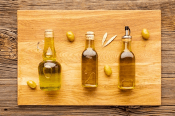
As you know, omega-6 fatty acids present in vegetable oils and nuts are good and necessary for supporting and balancing your overall health. Nonetheless, the problem may come when the intake of omega-6 fats is significantly higher than that of omega-3, which has been associated with acne due to the imbalance of the omega-6/omega-3 ratio in diets with a deficiency of omega-3.
Why can omega-6 fats cause acne?
Some studies have suggested that inflammatory markers correlate with an increase in the omega-6/omega-3 ratio, the reason why omega-6 fats are presumed to induce pro-inflammatory mediators that can promote the development of inflammatory acne [1].
Should you avoid omega-6 fats?
No. What you can do is increase the intake of food rich in omega-3 fats to reduce the omega-6/omega-3 ratio [8] to benefit from the anti-inflammatory effects of omega-3s [1].
7.
CHOCOLATE
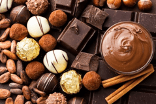
The effects of chocolate on acne exacerbation are still under exploration. Some recent studies have shown a weak relationship between chocolate intake and acne increase [9].
Why could chocolate cause acne?
Chocolate is normally composed of sugar, milk, butter, and cocoa. Sugar and milk are two factors we discussed that could trigger acne due to the contribution of a high-glycemic load and the presence of milk proteins.
But what about cocoa?
It’s not clear whether cocoa may contribute to acne or not. One study suggested that the consumption of unsweetened 100% cocoa by acne-prone male individuals could correlate to an increase in the exacerbation of acne [10]. However, no results can be conclusive.
Should you avoid chocolate?
Not really. You can still enjoy eating chocolate but in moderation.
FOOD THAT HELPS FIGHT ACNE
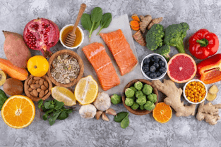
You may benefit not only from avoiding certain types of foods mentioned before but also from incorporating into your diet foods that can prevent or improve acne. Here are some suggestions:
Omega-3-rich food:
oily fish (such as salmon and sardines), fish oil and flaxseed oil, flaxseeds, walnuts, and chia seeds are rich sources of omega-3 fatty acids [8], which could help decrease the inflammatory factors related to acne.
Zinc:
this essential mineral has been associated with an improvement in acne. Food rich in zinc includes seafood (like oysters, crabs, and lobster), red meat, nuts, beans, and whole grains.
Antioxidant-rich food:
consumption of colorful fruits and vegetables as rich sources of antioxidant molecules can improve acne.
Green tea:
it contains catechin (epigallocatechin-3-gallate) that has been associated with anti-inflammatory and antiproliferative effects, inhibiting the mTORC1 signaling pathway linked to acne [5].
Vitamin A and D:
they have been associated with an antiproliferative action, improving acne. Vitamin A can be found in yellow vegetables (such as carrots, pumpkin, and sweet potatoes), tomatoes, fish oils, eggs, and leafy green vegetables, while Vitamin D can be found in salmon, tuna, sardines, beef liver, egg yolk, and Vitamin D fortified food.
Vitamin E:
this vitamin could also improve acne due to its antioxidant activity, helping to fight inflammation. Found in wheat germ, sunflower, and soybean oils, avocado,
almonds
, peanuts, spinach, and red bell pepper, among others.
BOTTOM LINE
The relationship between food and acne is still not clear. Evaluating how our diet impacts acne is difficult to assess since many other factors are also intrinsically related to acne development. However, one thing is clear and is that we are what we eat, and having a healthy diet can only improve our overall health. Avoiding certain types of foods may not necessarily be the cure for acne but reducing the intake of some of these foods mentioned or eating them in moderation along with a healthy diet, could certainly make a major favor to your skin condition.
REFERENCES
- Pappas, A. (2009). The relationship of diet and acne. Dermato-Endocrinology, 1 (5), 262–267. https://doi.org/10.4161/derm.1.5.10192
- Meixiong, J., Ricco, C., Vasavda, C., & Ho, B. (2022). Diet and acne: A systematic review. JAAD International, 7, 95–112. https://doi.org/10.1016/j.jdin.2022.02.012
- Smith, R., Mann, N., Braue, A., Mäkeläinen, H., & Varigos, G. (2007). A low-glycemic-load diet improves symptoms in acne vulgaris patients: a randomized controlled trial. The American Journal of Clinical Nutrition, 86 (1), 107–115. https://doi.org/10.1093/ajcn/86.1.107
- Juhl, C. R., Bergholdt, H. K. M., Miller, I., Jemec, G. B., Kanters, J. K., & Ellervik, C. (2018). Dairy Intake and Acne Vulgaris: A Systematic Review and Meta-Analysis of 78,529 Children, Adolescents, and Young Adults. Nutrients, 10 (8), 1049. https://doi.org/10.3390/nu10081049
- Melnik, B. C. (2012). Dietary intervention in acne. Dermato-Endocrinology, 4 (1), 20–32. https://doi.org/10.4161/derm.19828
- Kern, D. (2023, March 20). Diet and Acne. Acne.org. https://www.acne.org/diet.
- Kern, D. (2022a, March 31). Caloric Intake and Acne. Acne.org. https://www.acne.org/caloric-intake-and-acne
- Harvard Health. (2019, August 20). No need to avoid healthy omega-6 fats. https://www.health.harvard.edu/newsletter_article/no-need-to-avoid-healthy-omega-6-fats
- Kern, D. (2022b, March 31). Chocolate and Acne. Acne.org. https://www.acne.org/chocolate-and-acne
- Caperton, C. (2014, May 1). Double-blind, Placebo-controlled Study Assessing the Effect of Chocolate Consumption in Subjects with a History of Acne Vulgaris. PubMed Central (PMC). https://www.ncbi.nlm.nih.gov/pmc/articles/PMC4025515/

 By myulikeadmin
By myulikeadmin



